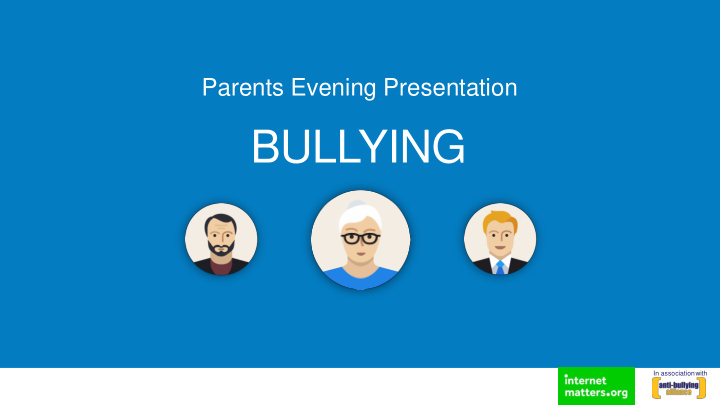



Parents Evening Presentation BULLYING In association with
Agenda Our schools approach 4 1 What is bullying? & how you can help Final thoughts 2 5 How common is bullying? 3 Spotting the signs
What is bullying? • Repetitive • Intentional • Power imbalance
Bullying is… The repetitive , intentional hurting of one person or group by another person or group, where the relationship involves an imbalance of power . Bullying can be physical , verbal or psychological Sexist or sexual Young carers, bullying Race, children in religion or care or home culture circumstance Different types of bullying Special Sexual education orientation It can happen face-to-face or online needs or Appearance disability or health conditions
Bullying can be ... Physical Verbal Emotional Pushing, poking, kicking, Name calling, sarcasm, Isolating others, tormenting, hiding hitting, biting, pinching etc. spreading rumours, threats, books, threatening gestures, ridicule, teasing, belittling humiliation, intimidating, excluding, manipulation and coercion
Bullying can be ... Online /cyber Sexual Indirect Posting on social media, Unwanted physical contact, Can include the exploitation sharing photos, sending inappropriate touching, of individuals abusive comments, nasty text messages, social homophobic abuse, exposure exclusion to inappropriate films etc.
30% 30% of 6-15 year olds have been bullied in the past year
TRUE Based on many different reports bullying levels within the previous academic year tend to fall between 25 – 30%
Children are five times more likely to be bullied online than at school
FALSE Children are five times more likely to be bullied at school than at online
16,000 11-15 year olds are absent from school at any one time due to bullying
TRUE Research from Red Balloon Learning Centre and National Centre for Social Research showed this to be the case
A whole school approach is important Immediate Media survey of 6-15 year olds showed that… 56% 87% 48% of bullied children were unsure of admitted feeling faced bullying in how to get help if they nervous telling school or someone they know someone about experiences bullying bullying
Spotting the signs 1 in 10 parents are aware their child has been bullied Change in behaviour Avoiding talking
Is this bullying? Dean’s parents have split up. Mark tells someone on social media and it then spreads around the whole school. Consider • Repetitive • Imbalance of power Not Need more bullying information Bullying • Intentional • Can be physical, verbal or psychological. • Hurtful • Can happen face-to-face or online
Is this bullying? Each time Ramon walks into a class a group of pupils giggle and whisper to each other. Consider • Repetitive • Imbalance of power Not Need more bullying information Bullying • Intentional • Can be physical, verbal or psychological. • Hurtful • Can happen face-to-face or online
Is this bullying? Tania and Susan won’t let Rachel play with them. Not Need more Consider Bullying bullying information • Repetitive • Imbalance of power • Intentional • Can be physical, verbal or psychological. • Hurtful • Can happen face-to-face or online
Our schools approach to bullying A chance for you to put some of your statistics relating to bullying levels in your school. Do you monitor levels of bullying? Also a chance to explain that you take cyberbullying seriously, that you want to work closely with parents to help tackle bullying in school . You could also include your school’s anti- bullying policy .
How can you help? Talking is the best way to help Encourage them not to treat bullying Remember this is an as a secret - they can use you as emotionally-charged problem release for their emotions; importantly keep the dialogue open Praise them for being brave enough to Stay calm, patient, and ask how you can help share with you Believe them, refrain from Think very carefully about approaching judging or belittling and other parents acknowledge their feelings
Always report bullying to the school Face to face Call us Email/Letter
FINAL THOUGHTS
More resources to explore
Any questions? In association with
Thank you
Recommend
More recommend